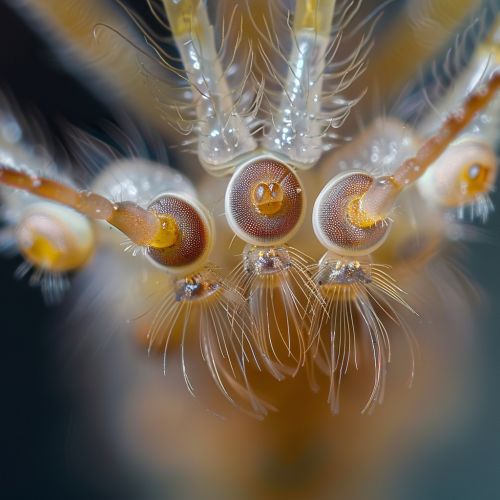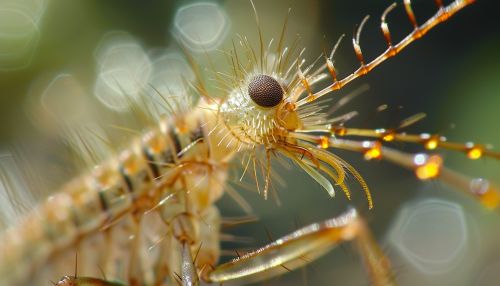Antennae (biology): Difference between revisions
No edit summary |
No edit summary |
||
| Line 7: | Line 7: | ||
Antennae are typically segmented and can be divided into three main parts: the scape, the pedicel, and the flagellum. The scape is the basal segment that attaches to the head. The pedicel is the second segment, which often contains the Johnston's organ, a sensory structure that detects motion. The flagellum consists of multiple segments and is the most variable part of the antenna. | Antennae are typically segmented and can be divided into three main parts: the scape, the pedicel, and the flagellum. The scape is the basal segment that attaches to the head. The pedicel is the second segment, which often contains the Johnston's organ, a sensory structure that detects motion. The flagellum consists of multiple segments and is the most variable part of the antenna. | ||
[[Image:Detail-79239.jpg|thumb|center|Close-up of insect antennae with visible segments and sensory structures.]] | [[Image:Detail-79239.jpg|thumb|center|Close-up of insect antennae with visible segments and sensory structures.|class=only_on_mobile]] | ||
[[Image:Detail-79240.jpg|thumb|center|Close-up of insect antennae with visible segments and sensory structures.|class=only_on_desktop]] | |||
The morphology of antennae can vary significantly among different arthropod groups. For instance, in insects, antennae can be filiform (thread-like), moniliform (bead-like), serrate (saw-like), pectinate (comb-like), or clavate (clubbed). In crustaceans, antennae can be biramous (branched) or uniramous (unbranched). | The morphology of antennae can vary significantly among different arthropod groups. For instance, in insects, antennae can be filiform (thread-like), moniliform (bead-like), serrate (saw-like), pectinate (comb-like), or clavate (clubbed). In crustaceans, antennae can be biramous (branched) or uniramous (unbranched). | ||
Latest revision as of 16:56, 17 May 2024
Introduction
Antennae, also known as feelers, are paired appendages used for sensing in arthropods. They are primarily found in insects, myriapods, and crustaceans. Antennae are highly specialized and vary greatly in form and function across different species. They play a crucial role in the sensory perception of the environment, aiding in navigation, finding food, and communication.
Structure and Morphology
Antennae are typically segmented and can be divided into three main parts: the scape, the pedicel, and the flagellum. The scape is the basal segment that attaches to the head. The pedicel is the second segment, which often contains the Johnston's organ, a sensory structure that detects motion. The flagellum consists of multiple segments and is the most variable part of the antenna.


The morphology of antennae can vary significantly among different arthropod groups. For instance, in insects, antennae can be filiform (thread-like), moniliform (bead-like), serrate (saw-like), pectinate (comb-like), or clavate (clubbed). In crustaceans, antennae can be biramous (branched) or uniramous (unbranched).
Sensory Functions
Antennae are equipped with various sensory receptors, including mechanoreceptors, chemoreceptors, and thermoreceptors. These receptors allow the organism to detect mechanical stimuli, chemical signals, and temperature changes, respectively.
Mechanoreception
Mechanoreceptors on the antennae are sensitive to touch, vibration, and air currents. These receptors help the organism detect physical contact with objects, navigate through the environment, and perceive the movement of other organisms. The Johnston's organ, located in the pedicel, is particularly important for detecting airborne vibrations and sound waves.
Chemoreception
Chemoreceptors are specialized for detecting chemical signals, such as pheromones and food odors. These receptors are crucial for behaviors like mating, foraging, and avoiding predators. Insects, for example, use their antennae to detect pheromones released by potential mates, which can trigger courtship behaviors.
Thermoreception
Thermoreceptors allow the organism to sense temperature changes in the environment. This capability is essential for thermoregulation, enabling the organism to seek out optimal temperatures for survival and reproduction.
Evolution and Diversity
The evolution of antennae has been driven by the diverse ecological niches occupied by arthropods. The structure and function of antennae have adapted to meet the specific sensory needs of different species. For example, the highly specialized antennae of moths are adapted for detecting pheromones over long distances, while the robust antennae of beetles are suited for tactile exploration of their surroundings.
Insects
Insects exhibit a wide range of antennae forms, each adapted to their specific lifestyle and environment. For instance, the plumose antennae of male mosquitoes are adapted for detecting the wingbeat frequencies of females, while the short, bristle-like antennae of ants are used for tactile communication and chemical detection.
Crustaceans
Crustaceans, such as crabs and shrimps, have antennae that are often biramous, with each branch serving different sensory functions. The primary antennae, or antennules, are typically involved in chemoreception and mechanoreception, while the secondary antennae are used for balance and locomotion.
Myriapods
Myriapods, including centipedes and millipedes, have relatively simple antennae compared to insects and crustaceans. Their antennae are primarily used for tactile exploration and detecting chemical cues in the environment.
Development and Regeneration
Antennae development occurs through a series of well-coordinated genetic and cellular processes. In insects, antennae develop from imaginal discs during the larval stages. These discs undergo extensive cell proliferation and differentiation to form the mature antennae.
Some arthropods have the ability to regenerate lost or damaged antennae. This regenerative capacity varies among species and is influenced by factors such as age, developmental stage, and environmental conditions. For example, certain crustaceans can regenerate their antennae through a process called autotomy, where the damaged appendage is shed and a new one is grown.
Ecological and Behavioral Significance
Antennae play a vital role in the ecological interactions and behaviors of arthropods. They are essential for locating food sources, avoiding predators, finding mates, and navigating complex environments.
Foraging
During foraging, antennae are used to detect chemical cues from potential food sources. For example, bees use their antennae to locate flowers by detecting floral scents, while ants follow pheromone trails laid by other members of their colony to find food.
Mating
Antennae are crucial for mating behaviors, particularly in species that rely on chemical communication. Male moths, for instance, use their antennae to detect pheromones released by females, which can attract them from great distances. Similarly, male beetles use their antennae to locate females by detecting specific chemical signals.
Antennae are also important for navigation, helping arthropods orient themselves and move through their environment. Insects like butterflies use their antennae to detect wind direction and navigate during migration. Crustaceans use their antennae to sense water currents and navigate through aquatic environments.
Antennae in Scientific Research
Antennae have been the focus of extensive scientific research due to their complex structure and diverse functions. Studies on antennae have provided insights into sensory biology, neurobiology, and evolutionary biology.
Sensory Biology
Research on antennae has advanced our understanding of sensory biology, particularly in the areas of chemoreception and mechanoreception. Studies have identified various sensory receptors and their roles in detecting environmental stimuli. For example, the identification of pheromone receptors in insect antennae has shed light on the molecular mechanisms underlying chemical communication.
Neurobiology
Antennae are also valuable models for studying neurobiology, as they contain a rich array of sensory neurons and neural circuits. Research on the neural processing of sensory information in antennae has provided insights into how the brain integrates and interprets sensory signals. For instance, studies on the Johnston's organ in insects have revealed how mechanosensory information is processed and used for behaviors like flight and mating.
Evolutionary Biology
The diversity of antennae forms and functions across arthropods makes them an important subject for evolutionary biology research. Comparative studies of antennae morphology and genetics have provided insights into the evolutionary pressures and adaptations that have shaped their development. For example, the evolution of specialized antennae in moths and beetles highlights the role of sexual selection and ecological niche specialization in driving morphological diversity.
